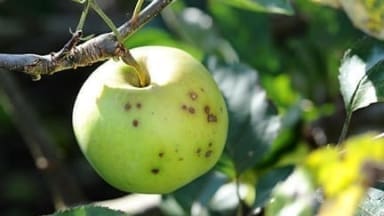
Overall, the persistent wet weather of 2023 contributed to the prevalence of diseases such as blossom wilt of fruit trees, pocket plum, tulip fire, and slime flux joining the top ten list for the first time.
The damp spring provided the perfect conditions for tulip fire – leading to a comeback into the top 10 for the first time in several years. The subsequent, wet and warm summer conditions led to a rise in reported cases of rose black spot and pear rust. Followed by the wet 2022/2023 winter, which resulted in waterlogged soils, which probably accounts for the increased prevalence of slime flux, known to colonise trees via their roots.
According to the Met Office, 2023 was relatively wet with 1,290mm of rainfall, equivalent to 111% of UK average rainfall which put it just outside the top 10 as the 11th wettest year in a series going back to 1836. 2023 had the the sixth wettest March and July, seventh wettest October and ninth wettest December. In addition, 2023 is the only year that has four individual months within the top 10 wettest on record for the respective month. Paired with the rain, 2023 was the record highest for the annual average daily minimum temperature for the UK, England, Wales and Northern Ireland, and fourth highest for Scotland.
Fruit trees continue to be under threat following the rise in fruit tree diseases seen in 2022. According to the RHS, increased planting of fruit trees in gardens in recent years, including heritage varieties that could be more prone to disease, is thought to be an additional factor in the dominance of fruit tree diseases. Apples, pears, and prunus are among the top five hosts, and were collectively the subject of over 1,000 enquiries to the RHS advisory service in 2023 – a 50% rise from 2022.
Top 10 2023 Garden Diseases
- Honey Fungus: Honey fungus remains at top spot for the 28th year running since the list was first published in 1995. Ubiquity is partly due to the Armillaria fungus having a large host range of more than 140 garden plants, particularly large woody ones. The most common victims in 2023 were privet, rose and viburnum. Honey fungus causes dramatic symptoms, including cracked and bleeding bark, failure to flower and plant death. The most characteristic symptom of honey fungus is white fungal growth between the bark and wood, usually at ground level.
- Apple and pear scab (pictured): Two fungal diseases that cause dark, scabby marks on the fruit and leaves of apples, pears and some other ornamental fruit.
- Rose black spot: Fungal disease of roses where purple or black spots develop on the leaves, which often drop early.
- Pear rust: Fungal disease of pear trees, causing bright orange spots on the leaves. It also affects junipers, causing perennial canker-like swellings on the branches.
- Blossom wilt in fruit trees: Fungal disease of apples, pears, plums, cherries and related ornamental trees. Wilt kills blossoms, spurs and small branches and is caused by the same fungi responsible for brown rot of the fruit.
- Bacterial leaf spot and canker of Prunus: Disease caused by two closely related bacteria that infect the stems and leaves of plums, cherries and related Prunus species. Cankers begin to form in mid-spring and soon afterwards shoots may die back. Shotholes appear on foliage from early summer.
- Phytophthora root rots: Found in the soil, phytophthora are microscopic, fungus-like organisms causing root and stem base decay of plants. Primarily a disease of heavy or waterlogged soils, and the symptoms can be very difficult to separate from those arising due to waterlogging itself.
- Pocket plum: Fungal infection of the young fruits of plums, damsons and some ornamental Prunus species, causing them to develop abnormally, without stones.
- Tulip fire: Fungal disease that causes brown spots and twisted, withered leaves in tulips
- Slime flux: New chart topper which troubles a wide variety of trees and shrubs, as well as clematis. Not usually fatal as is mainly found in damaged and rotting tissue but will need to be removed.
Liz Beal, RHS Plant Pathologist, said: “Unusually wet weather in 2023 had a significant effect on plant health across the UK, with the prevalence of tulip fire and pocket plum demonstrating the impact of prolonged damp conditions. Following the extreme drought of the previous year, many gardeners are left wondering how to prepare for unpredictable weather patterns. Understanding the conditions of your garden is key in deciding which plants will thrive where; the right plant in the right place will always have a better chance of fighting off infection. Additionally, gardeners can help combat many of the most common diseases in our ranking by practising good hygiene, keeping tools clean and removing – and safely disposing of – diseased plant material from their gardens.”
The RHS Plant Health team uses the disease ranking to inform their research and advice. Ongoing research projects at RHS Hilltop include characterising the dispersal mechanisms and variation of honey fungus populations, investigating the efficacy of silicon as a treatment for rose black spot, and investigating the effective management of Phytophthora in gardens, such as whether Phytophthora root rot remains present in previously cleared areas.

